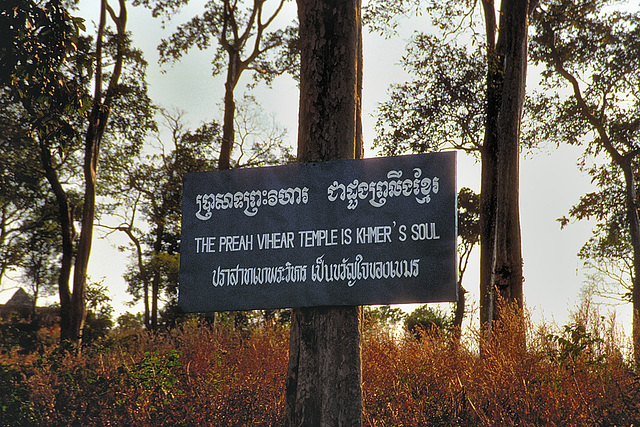Relief of catching a "Nāga" snake
Remains of the first level
Beside the historical path of Phra Vihaan
Way back to the first level
Crashed down chopper at Khao Phra Vihaan
Way back to the third level
Details of the lentil carvings
Warning signs beside the walk
At the edge of the Pay Ta De
Khao Phra Vihaan map
Third level of the Prasat Khao Phra Vihaan
Prasat Khao Phra Vihaan, Cambodia
The "Nāga" gate into the Gopura on the third level
First level of Khao Phra Vihaan
The eastern wing of the temple complex
The scarp south of Phra Vihaan
South entrance into the Gopura complex
First level of Khao Phra Vihaan
Thai monks visiting the remains of killing machine…
Gopura of the third level
Debris inside the yard of Phra Vihaan
Collapsed prang and lentil at the fourth level
Very well preserved lintel
Naga Balustrade
Walking on the edge of Khao Phra Vihaan
Way back to the first level
Beautiful carved lintel being in good condition
Debris of the Central Sanctuary
Monks entering the Gopura complex
Entrance to the Phra Vihaan hill
Get to the Gopura of the second level
Marines from USA catching a Nāga snake
Beside the historical path of Phra Vihaan
Location
See also...
Keywords
Authorizations, license
-
Visible by: Everyone -
All rights reserved
- Photo replaced on 06 Jan 2013
-
1 420 visits
Prasat Khao Phra Vihaan is a Holy Cambodian national symbol


In modern times, the temple's location on the border between Cambodia and Thailand led to a dispute over ownership. In 1954, Thailand formally occupied the temple. In 1959, Cambodia applied to the International Court of Justice in the Hague to rule that the temple lay in Cambodian territory. In subsequent proceedings before the court, Cambodia based much of its case on a map drawn up in 1907 by French officers, some of whom had been part of a 1904 joint border demarcation commission formed by Thailand, then known as Siam, and the French colonial authorities then ruling Cambodia. The map showed the temple as being in Cambodia and was sent to the Siamese authorities as part of formal border demarcation activities. Over the subsequent five decades, in various other international forums, according to Cambodia, the Siamese/Thai authorities did not formally object to the map’s depiction of the temple’s location. Nor did the Siamese object when a French official from the colonial administration received the Siamese scholar and government figure Prince Damrong at the temple in 1930.
Thailand counter-argued that the map was not an official document of the 1904 border commission. It also noted that the mutually accepted principle governing demarcation by that commission was that the border would follow the watershed line along the Dângrêk mountain range, which the Thais said would put the temple in Thailand. Thai authorities never felt the need to formally object to the map, the court was told, because they had practical ownership of the temple. Any acceptance of the map, the court was informed, was based on a false understanding that it followed the watershed line.
On June 15, 1962, the court ruled that through its long lack of objection and its accepting and benefiting from other parts of a border treaty that grew from the 1904 commission's work, Thailand had in effect accepted the 1907 map, overriding any question of the watershed line, and that the temple belonged to Cambodia. The court declined to take up the question of whether the border as mapped in the vicinity of the temple corresponded to the watershed line. Thailand accepted the court's decision, but many Thais continue to believe that the decision was unfair. The accepted border line now passes just a few meters from the base of the southern steps.
Thailand counter-argued that the map was not an official document of the 1904 border commission. It also noted that the mutually accepted principle governing demarcation by that commission was that the border would follow the watershed line along the Dângrêk mountain range, which the Thais said would put the temple in Thailand. Thai authorities never felt the need to formally object to the map, the court was told, because they had practical ownership of the temple. Any acceptance of the map, the court was informed, was based on a false understanding that it followed the watershed line.
On June 15, 1962, the court ruled that through its long lack of objection and its accepting and benefiting from other parts of a border treaty that grew from the 1904 commission's work, Thailand had in effect accepted the 1907 map, overriding any question of the watershed line, and that the temple belonged to Cambodia. The court declined to take up the question of whether the border as mapped in the vicinity of the temple corresponded to the watershed line. Thailand accepted the court's decision, but many Thais continue to believe that the decision was unfair. The accepted border line now passes just a few meters from the base of the southern steps.
(deleted account) has particularly liked this photo
- Keyboard shortcuts:
Jump to top
RSS feed- Latest comments - Subscribe to the comment feeds of this photo
- ipernity © 2007-2024
- Help & Contact
|
Club news
|
About ipernity
|
History |
ipernity Club & Prices |
Guide of good conduct
Donate | Group guidelines | Privacy policy | Terms of use | Statutes | In memoria -
Facebook
Twitter

Ich bin Administrator der Gruppe Schrift und fände es toll, dieses Bild in unserer Gruppe sehen zu können.
Lars Sözüer has addedSign-in to write a comment.